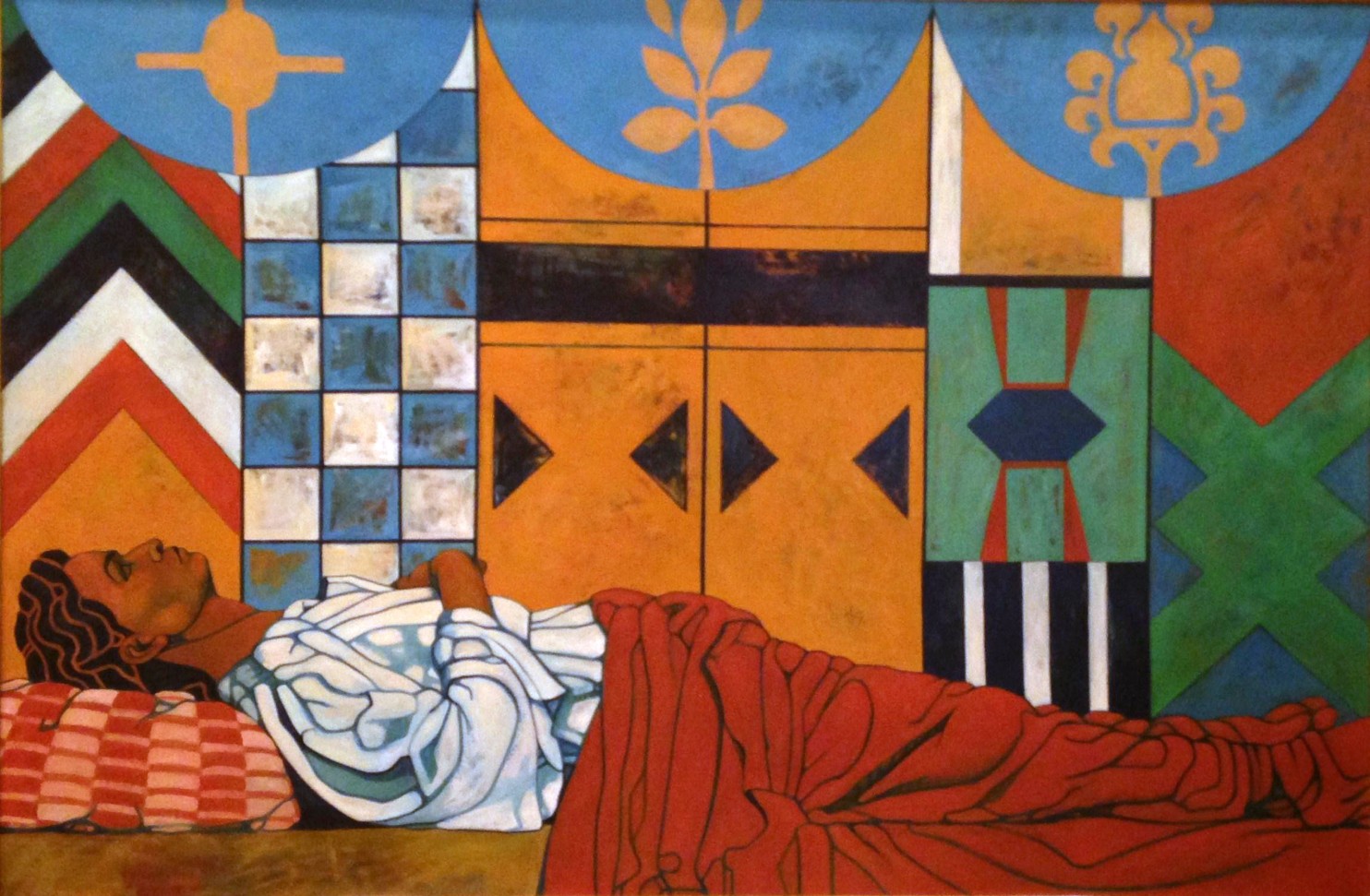![]()
![]()
![]()
Dee Levinson
Home | Exhibitions | Current Paintings | Reviews | Resume | Contact Information
The paintings in Dee Levinson’s Touchstone Gallery show, “Religions of the World,” began with an epiphany, but it wasn’t a sectarian one. Visiting Rome in 1991, the Arlington artist was struck by the forms and lines of the abundant public sculpture. Levinson works from photographs to depict these and other statues in a hard-edge style that emphasizes depth and modeling. Rather than simulate the tones of marble and bronze, though, the painter uses bold complementary colors, pitting red against green or purple against yellow. To this pop-art clash, she often adds gold, which denotes holiness in both Western and Eastern traditions.
Since Levinson’s inspiration derives from travels in Europe, the majority of her subjects are Christian. But she also paints heroic and godly figures from Judaism, Buddhism and the ancient Egyptian pantheon, as well as an abstract Islamic design. The images are not devotional, and can even be ever-so-slightly heretical. The artist’s version of an Eastern Orthodox icon depicts Russian-born Touchstone director Ksenia Grishkova — not a saint or a goddess, perhaps, but exalted by Levinson’s neon-hued neoclassicism.
Dee Levinson: Religions of the World Through July 30 at Touchstone Gallery, 901 New York Ave. NW. Washington, DC
Local Spotlight: Dee Levinson at Touchstone Gallery
By Mark Jenkins, January 19, 2017 The Washington Post Review

Most of the paintings in Dee Levinson’s “Looking Back: Across Time and Culture” depict ancient Egyptian gods and royalty, but the Virginia artist’s style reflects a much later moment. The pictures in her Touchstone Gallery show suggest the pre-Raphaelites, eminent Victorians who were also keen on looking back.
Levinson’s color schemes, dominated by earth and metallic tones set off by intense blues, evoke the land of the pharaohs. Her use of shadows and modeling, however, draws from the European medieval and Renaissance masters whose styles the pre-Raphaelites endeavored to revive. The artist’s subjects include European, Chinese and American Indian figures, some historical and others mythical. What they all share are vivid renderings, saturated colors and a sense of mysterious, vanished grandeur.
Dee Levinson: Looking Back: Across Time and Culture On view through Jan. 28 at Touchstone Gallery, 901 New York Ave. NW. Washington, DC202-347-2787.
In keeping pace with this pseudo-thought experiment, the paintings of Dee Levinson occupy a unique place among the creative forces of old and new. On view at Touchstone Gallery, 901 New York Ave. NW, through Feb. 28, Levinson’s work is contemporary, fresh and alive, while also recalling a romantic classicism from across the art historical landscape.
Upon first seeing Levinson’s paintings, the idea of “Greco-Nouveau” materialized quite immediately in my mind. Imagine if Alphonse Mucha or Gustav Klimt were to make studies of ancient Greek sculptures: marbled, graceful and stoic figures with a stark, two-toned contrast against dramatic light, enveloped by flowing planes of flat textile and floral patterns. The compositions seem to billow forth from the canvas.
In the best possible way, they are rather like paintings of sculptures, capturing a certain ethos and grandness of the ancient arts in an altogether new light.
And yet there are a range of other aesthetics and influences that Levinson folds into her work. “Le Reina Plata” is a bold portrait of an aged Native American woman, whose face bears a wise, matronly pride as it gazes into the distance. This pose could invariably signify something like the envisioning of new horizons — say, promise for future generations — or a more sober reckoning with her own mortality and place in a vast, beautiful world.
Surely, there is a purpose and a history in this painting. But like a Greek sculpture, this portrait also has the power to transcend historical knowledge with a more universal, inherent beauty. It is at its core a depiction of humanity, imbued and heightened with a historical specificity and distilled into an eternal moment.
Levinson uses this aesthetic vocabulary to build emotional connections and leave distinct impressions with her audience. By turns searching and exploratory, beautiful and moving, bold and delicate, her work is a delight.
It is also work that connects currently with our city's museum offerings. It is hard not to make connections between these paintings and the recent exhibition of Hellenistic bronze sculptures at the National Gallery, “Power and Pathos.”
http://www.georgetowner.com/articles/2016/feb/24/local-spotlight-dee-levinson-touchstone-gallery/
Levinson’s painting “Las Reinas Tres” depicts three crowned female figures, each armored and cloaked in billowing fabric. At their feet sit three lions and two globes, as if to drive the point across that these women tower above us. This piece of artwork was based off a statue Levinson photographed in Spain. Levinson said most of her pieces are based off of statues she photographed while abroad. This explains why it is difficult to nail down the period that Levinson’s collection is based on; her paintings are based on statues from various eras and cultures, the subjects of which range from the Virgin Mary to Buddha and from Greek gods to Victorian women.
John Blee and Dee Levinson’s paintings are aesthetically
pleasing to the eye, making them accessible even to those with no knowledge of
art. Though some may say that the paintings come off as slightly esoteric,
needing to be interpreted and examined for meaning. The artists who created them
both assert that the paintings are visual representations of their own
experiences. I would encourage any art lover who attends the Touchstone Gallery
not to attempt to find the artist’s intended meaning behind each painting, but
rather to see each painting for it’s visual beauty and to find personal meaning
within each.
This collection will be on display at the
Touchstone Gallery, located at 901 New York Ave NW, Washington, DC 20001, till
February 28th.
http://georgetownvoice.com/2016/02/10/80784